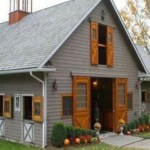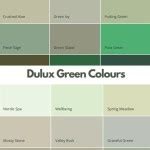What Color To Paint My Wood Fence In Georgia
Choosing the right color to paint a wood fence in Georgia requires careful consideration of several factors. The intense sunlight, humid climate, and specific aesthetic preferences of the homeowner all play a crucial role in making an informed decision. A well-chosen color can significantly enhance the curb appeal of a property, protect the wood from the elements, and complement the surrounding landscape.
The goal of this discussion is to provide a comprehensive guide to selecting the optimal paint color for a wood fence in the specific context of Georgia. It will address the practical implications of color choice, including weathering, maintenance, and compatibility with the environment. The following considerations will help determine the best course of action for any wood fence painting project in the state.
Considering the Georgia Climate
Georgia's climate, characterized by hot, humid summers and mild winters, presents unique challenges for exterior paint. The intense sun can cause fading and cracking, while the humidity can promote mold and mildew growth. Therefore, the color of the paint should be chosen with these factors in mind. Lighter colors generally reflect more sunlight and heat, which can help to prevent the paint from overheating and cracking. This is particularly important for darker-stained or painted fences, which tend to absorb more heat.
Furthermore, the presence of moisture in the air and soil can accelerate the growth of organic matter on the fence. Paint colors that are susceptible to showing mildew stains, such as very light shades or pure whites, may require more frequent cleaning and maintenance. Selecting a color that can conceal dirt and mildew growth, or one that is specifically formulated with mildew-resistant additives, can reduce the overall upkeep required for the fence.
The frequency of rainfall in Georgia also contributes to the weathering process. The constant exposure to moisture can lead to the paint peeling or blistering, especially if the wood is not properly prepared before painting. A high-quality primer and paint that are specifically designed for exterior use are essential for protecting the wood from the elements. Moreover, selecting a color that complements the natural tones of the environment can help to minimize the visual impact of any weathering that may occur.
Harmonizing with the Landscape and Architecture
The color of a wood fence should complement the surrounding landscape and the architectural style of the house. In Georgia, this often means considering the rich greenery of the trees and shrubs, the earthy tones of the soil, and the specific color palette of the home's exterior. A fence that blends seamlessly with its surroundings will create a more cohesive and aesthetically pleasing overall appearance.
For homes with traditional architecture, such as Georgian or Victorian styles, classic colors like white, off-white, or light gray may be the most appropriate choice. These colors evoke a sense of elegance and timelessness, and they can enhance the architectural details of the house. Alternatively, for homes with more modern or contemporary designs, bolder colors like dark gray, brown, or even black can be used to create a striking contrast.
The color of the fence should also be coordinated with the other exterior elements of the property, such as the siding, roofing, and trim. A consistent color scheme will create a sense of harmony and balance, while a mismatched color palette can appear disjointed and unappealing. It is often helpful to take photographs of the house and surrounding landscape and then experiment with different color options using online design tools or paint samples.
Consider the existing colors of your landscaping elements as well. If you have a garden with bright, vibrant flowers, a neutral fence color will allow the plants to stand out. A white or light gray fence provides a clean backdrop that enhances the colors of the flowers and foliage. If your landscape is more subdued with mostly green foliage and brown mulch, a slightly darker or more colorful fence can add visual interest.
Practical Considerations: Maintenance and Durability
Beyond aesthetics, the practical aspects of fence maintenance and durability should also influence the color selection process. Certain colors are more prone to showing dirt, mildew, and fading, which can increase the amount of upkeep required to keep the fence looking its best. Darker colors, for instance, tend to absorb more heat and are more susceptible to fading and cracking in the intense Georgia sun. Light colors, on the other hand, may show dirt and mildew more readily.
The type of paint used also plays a significant role in the durability of the fence. High-quality exterior paints are formulated with UV inhibitors, mildewcides, and other additives that help to protect the wood from the elements. These paints are more expensive than cheaper alternatives, but they will ultimately save time and money in the long run by reducing the need for frequent repainting. Oil-based paints are known for their durability and resistance to moisture, but they can be more difficult to apply and clean up than latex-based paints. Latex-based paints are more environmentally friendly and easier to work with, but they may require more frequent recoating.
Consider also the long-term maintenance commitment. While a specific color might be aesthetically pleasing initially, the commitment to maintaining that aesthetic is crucial. Darker colors often highlight imperfections in the wood and require more attention to ensure even coverage during painting. Lighter colors might reveal stains and dirt more readily. Evaluate the willingness and ability to perform regular cleaning and touch-ups based on the chosen color.
A semi-gloss or satin finish is generally recommended for wood fences, as these finishes are easier to clean and more resistant to mildew growth than flat finishes. A glossier finish will also reflect more light, which can help to keep the fence cooler in the summer. However, it is important to note that glossier finishes may also highlight imperfections in the wood, so proper surface preparation is essential.
Furthermore, the color of the paint should be compatible with the existing primer or stain on the wood. If the fence has already been painted or stained, it may be necessary to apply a primer before painting to ensure proper adhesion and prevent bleed-through. Consulting with a paint professional can help to determine the best primer and paint combination for a specific wood fence.
Popular Color Choices for Georgia Wood Fences
Several color choices are consistently popular for wood fences in Georgia, each offering its own unique aesthetic and practical advantages. White fences are a classic choice, providing a clean and timeless look that complements a wide range of architectural styles. White is also a reflective color, helping to keep the fence cooler in the summer and reducing the risk of fading. However, white fences require more frequent cleaning to remove dirt and mildew stains.
Off-white or cream-colored fences offer a similar aesthetic to white fences, but they are slightly more forgiving when it comes to hiding dirt and mildew. These colors are also less stark than pure white, which can make them a more appealing choice for some homeowners. Light gray fences are another popular option, providing a neutral backdrop that blends seamlessly with the surrounding landscape. Light gray is also a versatile color that can be paired with a variety of architectural styles and trim colors.
Brown fences are a natural choice for wood fences, as they mimic the color of the wood itself. Brown fences can range from light beige to dark chocolate, and they can be stained or painted depending on the desired level of coverage. Brown fences are relatively easy to maintain, as they tend to hide dirt and mildew well. However, darker shades of brown can absorb more heat and may be more prone to fading in the sun.
For homeowners who want to make a bolder statement, dark gray or black fences can be a striking choice. These colors create a dramatic contrast with the surrounding landscape and can add a touch of modern elegance to a property. However, dark colors absorb more heat and may be more prone to fading, so it is important to use a high-quality paint with UV inhibitors.
Ultimately, the best color for a wood fence in Georgia will depend on the specific preferences of the homeowner, the architectural style of the house, and the surrounding landscape. By considering the factors outlined in the discussion, property owners can make an informed decision that will enhance the curb appeal of the homes and protect the fence from the elements for many years to come. Sample boards are highly recommended before a final color selection is made for any exterior project.

How To Paint A Wood Fence The Fast And Easy Way

How To Choose A Fence Color

Tips On How To Properly Paint A Wood Fence Action

Best Colors To Paint Your Fence Highlands Ranch

How To Paint A Wood Fence The Fast And Easy Way

Atlanta Fence Staining Sealing Company Bravo

Stain Vs Paint Fence First Of Georgia

Residential Fence In Georgia Wooden Vinyl Steel

How To Paint A Wood Fence The Fast And Easy Way

How To Choose A Fence Color
Related Posts








